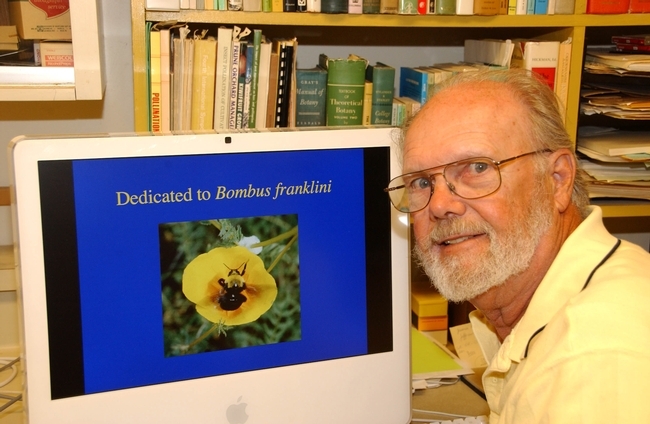Is Franklin's bumble bee extinct or is it just elusive?
Annual search parties conducted since 2006 have failed to locate the species.
Now scientists may learn its status via DNA "fingerprints."
A recent article in the National Geographic indicated: "For the past several years, the wildlife service (U.S. Fish and Wildlife Service) and the U.S. Geological Survey have been developing a DNA fingerprint for Franklin's bumblebee. Once it's complete, scientists will be able to test flower samples for the bee's genetic material—they wouldn't need to see the bee to determine it's still alive and has recently visited a particular area."
Fascinating news, and news that the late Robbin Thorp (1933-2019), distinguished emeritus professor of entomology at UC Davis and a global expert on bumble bees, would have treasured.
Franklin's bumble bee, Bombus franklini, inhabits--or did--a 13,300-square-mile area confined to five counties--Siskiyou and Trinity counties in California; and Jackson, Douglas and Josephine counties in Oregon. It's now on the list of federally endangered species, and Thorp (partnering with the Xerces Society for Invertebrate Conservation), helped put it there.
Thorp, a member of the UC Davis entomology faculty for 30 years (1964-1994) and co-author of the landmark Bumble Bees of North America: an Identification Guide, closely monitored the population for more than two decades. His surveys clearly showed the declining population. His sightings decreased from 94 in 1998 to 20 in 1999 to 9 in 2000 to one in 2001. Sightings increased slightly to 20 in 2002, but dropped to three in 2003. He saw none in 2004 and 2005; one in 2006; and none since.
We chronicled his many trips to the five-county area to search for the elusive bumble bee, and his never-fading optimism.
Thorp's determined hunt resulted in the CNN publication of "The Old Man and the Bee," a spin-off of Hemingway's "The Old Man and the Sea."
We remember his excitement every time folks telephoned or messaged him that "I think I found it!" (Here's what it looks like.)
"Don't give me a heart attack," he'd reply.
Named in 1921 for Henry J. Franklin (who monographed the bumble bees of North and South America in 1912-13), Franklin's bumble bee frequented California poppies, lupines, vetch, wild roses, blackberries, clover, sweet peas, horsemint and mountain penny royal during its flight season, from mid-May through September. The bumble bee "collects pollen, primarily from lupines and poppies, and gathers nectar mainly from mints," Thorp told us.
Fast forward to today. Is the species extinct, as many scientists think?
"Even after 15 years, it's not unrealistic to think Franklin's bumblebee will be found," Matt Kelly wrote in National Geographic. "There are notable examples of researchers rediscovering bees and other insects after they've been presumed to be extinct: The blue calamintha bee was found after nine years without a sighting in Florida; Fender's blue butterfly was found after 52 years in Oregon; and Wallace's giant bee, the world's largest, was rediscovered after 122 years in Indonesia. Of the more than 350 species rediscovered since 1889, the average time between the last sighting and rediscovery is 61 years, a 2011 study found."
The DNA fingerprints may reveal what Thorp has always thought: "It's out there somewhere."
Attached Images:
